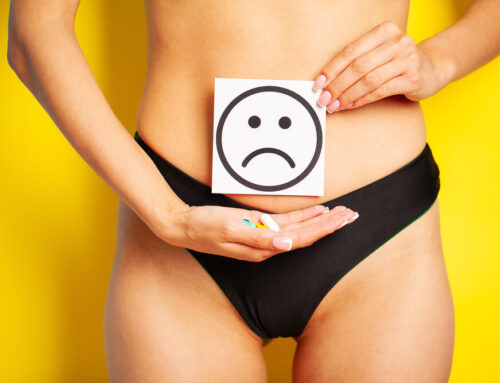Unfortunately, vaginal dryness is a rather common condition in women who have been through menopause and those who had both ovaries removed surgically for some reason (for instance, to treat or prevent malignancies).
Some experts may also refer to the condition as “genitourinary syndrome of menopause” or “atrophic vaginitis.”
There are cases when the condition causes no discomfort to the patient. Still, there are also instances where it may cause uncomfortable symptoms such as burning sensations, vaginal itching, abnormal discharge, and pain during sex. Vaginal dryness may also lead to unpleasant urinary symptoms, which may result in less satisfying sex life and decreased sexual intimacy, which can even lead to mental problems.
Luckily, those women who are looking for vaginal dryness treatment can choose from a range of different therapies such as lubrication options, vaginal estrogen cream, prasterone, and many more.
Exploring the Causes of the Condition
In order to treat the condition, healthcare experts must understand the causes of vaginal dryness. In essence, estrogen helps to maintain the vagina’s moisture levels and keep the vaginal tissue elastic or flexible. As such, dryness will mostly occur when the female body fails to produce enough estrogen either temporarily or permanently.
This may happen due to the following:
- Menopause
- Oophorectomy, or the removal of the ovaries
- Radiation therapy
- Chemotherapy
- After pregnancy – breastfeeding women may experience symptoms of vaginal dryness because, during breastfeeding, estrogen production becomes altered, but once the mother ceases to breastfeed, hormone production should return to normal.
- The use of certain medications like danazol, leuprolide, nafarelin, and medroxyprogesterone; once the patient stops taking these compounds, estrogen production should return to normal.
Treatment for Vaginal Dryness

Fortunately, the condition may be treated in several ways, and some of these options, like lubricants and vaginal moisturizers, don’t even require women to get a prescription.
Also, there are some compounds that require a prescription (such as vaginal estrogen creams, rings, prasterone, ospemifene, capsules, and tablets).
Lastly, women may also choose minimally-invasive treatment options like vaginal lasers and other energy-based methods (think about the MonaLisa Touch treatment). Finally, there are also vaginal dryness natural remedies that may be able to ease symptoms.
Below, we will say a few words about each of these options.
Vaginal Moisturizers and Lubricants
As said, these compounds can be bought without a prescription, and they don’t contain hormones. Also, they won’t cause any body-wide side effects, but possible local reactions may include burning sensations or slight irritation.
Lubricants are applied either on the partner’s penis or inside the vagina before sex to reduce discomfort and friction. Experts usually recommend using water or silicone-based lubricants to avoid any damage to latex condoms and diaphragms, which can be less effective at preventing STIs and unwanted pregnancy.
Vaginal moisturizers usually contain hyaluronic acid that allows the vagina to remain moist. For the best results, experts recommend applying it three times a week.
Vaginal Estrogen Products
These are among the most effective treatments for treating vaginal dryness. Their usage requires a doctor’s prescription and is usually recommended if the options above fail to work.
These vaginal estrogen creams, tablets, or capsules help restore the topmost vaginal cell layers, increasing elasticity when used regularly.
Some women may worry about the side effects that vaginal estrogen creams and insertable rings, capsules, or tablets may cause due to their hormonal content. Fortunately, only a tiny amount of estrogen enters the bloodstream when using vaginal forms, meaning that the risk of experiencing side effects is also low. While they are very effective treatments for vaginal dryness, the usage of these tablets, rings, capsules, and creams should be discussed with a doctor first.
In some cases, women may also need to take progestin alongside these vaginal estrogen creams to prevent buildup in the uterine lining, which may even lead to malignancies. Still, in low-dose cases, taking progestin is unnecessary. Again, it’s best to ask your healthcare provider about your options if you are considering vaginal estrogen.
Also, some experts in the field debate whether these compounds are safe to use for women who have a history of breast cancer.
Prasterone is another hormonal treatment option (also called DHEA or dehydroepiandrosterone). Prasterone is a suppository medication that turns into testosterone and estrogen in the vagina and can ease vaginal dryness symptoms in postmenopausal women.
Next to prasterone, women may also opt for ospemifene, which is another vaginal estrogen alternative. Ospemifene is an oral option for those who are looking for estrogen-like options for vaginal dryness but want to avoid applying/inserting vaginal medication. It’s important to note that the compound may cause hot flashes and, in more severe cases, may increase the risk of uterine cancer and blood clots. More long-term research and studies are needed to evaluate the potential risks of this option.
Vaginal Dryness: Natural Remedies

On the other hand, vaginal dryness may also respond well to natural, home-based remedies that can help ease the patient’s discomfort.
For instance, a study from 2014 on sea buckthorn oil suggested that the regular usage of the compound may improve vaginal tissue integrity and elasticity. Still, some participants also experienced stomach issues and increased joint pain near the study’s end.
Other supplements and vitamins may also help, including:
- Beta carotene
- Vitamins E, A, and B
- Omega-3 fatty acids
Also, maintaining a healthy weight and avoiding crash diets can help. Additionally, women with vaginal dryness may consider adding foods high in plant-based estrogen into their diets, like flaxseed, soy products, and soybeans. Cutting down on alcohol and caffeine is also highly recommended.
Regular but moderate exercise can help in improving blood flow and hormone levels. And lastly, healthcare experts will often recommend avoiding douches and other fragranced hygiene products that may irritate the vagina and worsen symptoms.
Vaginal Lasers
Other therapies, such as the MonaLisa Touch treatment, can also reduce and reverse atrophy symptoms. The procedure is free of chemicals and hormones, focusing on restoring the natural function of the vagina with the help of low-heat lasers that emit energy pulses, penetrating into vaginal tissue. The lasers stimulate collagen, elastin, and natural lubrication production in the vagina, reducing symptoms of vaginal dryness.
There Is Help
There are several available options regarding treatment for vaginal dryness. Based on the option you’ve chosen, you will be able to experience improvements within a few weeks. And the good news is, when sex isn’t uncomfortable anymore, regular intercourse can help keep the vaginal tissue elastic and soft.
If you are looking for an effective treatment option but have concerns about the best course of action, feel free to reach out to Dr. Krinsky and learn more about the whole process today.



